5 Bengali Recipes You Should Try

Bengal’s cuisine is as diverse and varied as the state itself. The rule of the Nawabs had a profound impact on Bengali cuisine, which is a fusion of delicate and spicy flavors. There are specific European influences, such as the snack food culture and meals such as chops and cutlets, which are British in origin but are cooked and served in the majority of Bengali families. Bangladesh is well-known for being the land of maach (fish) and bhaat (rice). Bengalis have an unbreakable bond with these two meals, which are staples in nearly every family. Because several rivers surround the state, fresh sweet water fish such as rui, pabda, and koi are popular. Surprisingly, more than forty different species of freshwater fish are commonly offered in Bengal. An oily fish known as ‘Hilsa’ or ‘Ilish’ is a popular local dish in Bengal. It is known as the “queen of fish” because of its delicate meat, distinct flavor, and silvery appearance. In reality, hilsa is very important culturally in Bengal, and a pair of hilsa fish are frequently purchased on auspicious occasions. Tubers, gourds, and roots predominate on the vegetarian buffet. Plantains, potatoes, water lily roots, brinjal, and beans are among the vegetables on the menu.
Bengali food combines sweet and spicy flavors. The precise balance of the primary ingredients and spice takes center stage. The use of ‘phoron,’ or a traditional blend of savory herbs, elevates even the most simple dishes to an extraordinary level. The ‘panch phoron’ is liberally used and consists of five spices: cumin, nigella, fenugreek, aniseed, and mustard seed. Bengali curries are distinguished by the unique flavors of mustard oil, poppy seeds, turmeric, and the sweet undertones imparted by warm spices like cinnamon, cardamom, nutmeg, and mace. Luchi is a deep-fried bread famous in this region and is made with refined and whole-wheat flour. Mishti Doi, a sweetened yogurt with rich jaggery overtones, is a standard complement. Overall, the robust fish curries and decadent Bengali sweets easily steal the show. Here are the top 5 Bengali recipes you should consider trying.
Kacchi Biriyani
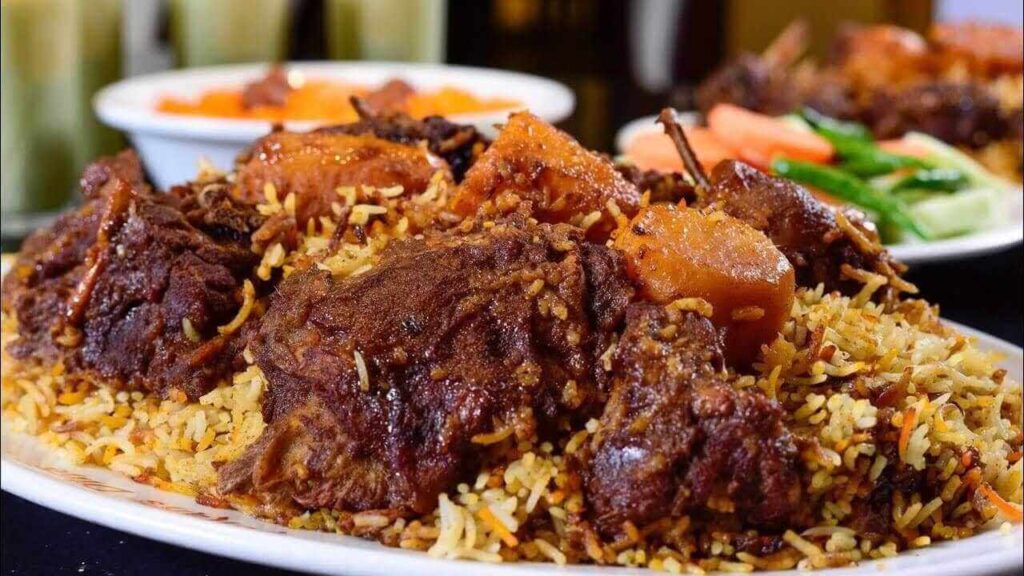
What’s a biryani without some delicious bits of lamb enclosed by an ideal mix of fragrant flavors and spices? Indeed, however, with different meats being more regular, biryani eaters worldwide can undoubtedly agree that mutton is the best choice. Furthermore, not simply biryanis, curries, bakes, and any remaining arrangements with this extraordinary meat are consistently exceptional. Did you know, in contrast to different dishes, a day-old mutton prep will always be all the more delicious on the sense of taste! Give it a try when you are planning to make this fantastic meal.
Planning Time: 1.30-2 hour
Cook time: 41-50 minutes
Serve: 4
Level Of Cooking: Moderate
Taste: Spicy
Ingredients
Mutton 1-inch cubes 350 grams
Basmati rice 1 cup
Onions 4 large
Yogurt 1/2 cup
Ginger paste 2 teaspoon
Garlic paste 2 tablespoons
Turmeric powder 3/4 teaspoon
Red chili powder 1 tablespoon
Coriander powder 1 teaspoon
Salt to taste
Ghee 6 tablespoons
Green cardamoms 3
Black cardamoms 3
Cloves 4
Cinnamon 1 1/2 inch sticks
Bay leaves 2
Star anise 2
Cumin seeds 1 1/2 teaspoon
Green chilies sliced 6-7
Tomatoes chopped 4 medium
Dry ginger powder 1 teaspoon
Cumin powder 1 teaspoon
Fresh mint leaves chopped 1/2 bunch
Fresh coriander leaves chopped 1 bunch
Saffron 4-5 strands
Milk 2 tablespoons
Directions
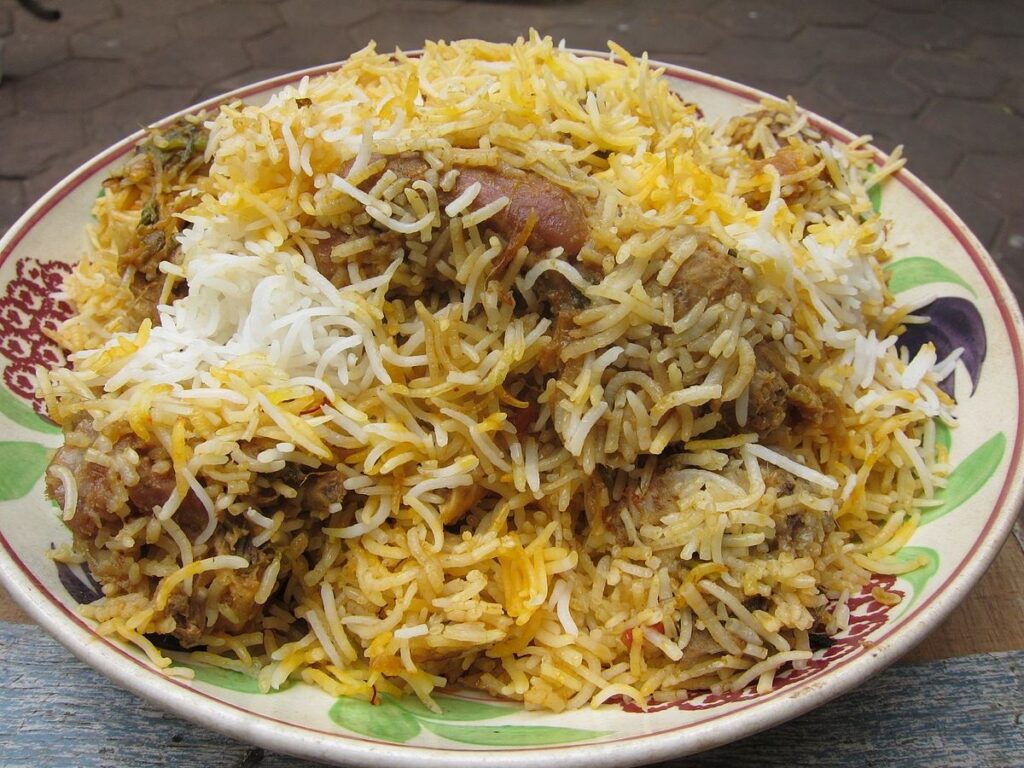
Step 1
Splash basmati rice in a few cups of water for 30 minutes. Channel and keep to the side.
Step 2
Cut two onions and slash the excess two.
Step 3
Marinate lamb with yogurt, a large portion of the ginger-garlic powder, a large amount of turmeric powder, a large part of the red chili powder, a significant bit of the coriander powder, and salt somewhere around one and a half hours, ideally in the cooler.
Step 4
Warmth ghee in a handi and fry cut onions till brown. Channel onto an absorbent paper and keep it to the side.
Step 5
To similar ghee, add green cardamoms, dark cardamoms, cloves, cinnamon, cove leaves, star anise, cumin seeds and let them snap.
Step 6
Add cleaved onions and sauté till brilliant brown.
Step 7
Add ginger-garlic powder, green chilies, tomatoes, and all the leftover masala powders, including ginger and cumin powder.
Step 8
Eliminate lamb pieces from the marinade and add. Sauté for a few minutes and afterward add marinade blend, mint leaves, and a few cups of water and cook the lamb till half has done.
Step 9
Add drained rice, a big part of the hacked coriander leaves, and two cups of water. Blend well, cover, and chili on low warmth.
Step 10
When it is almost done, add saffron broke up in two tablespoons of milk and blend tenderly.
Step 11
Cover and cook till completely done. Mix biryani a long time prior to serving.
Step 12
Decorate with remaining chopped coriander leaves and fried onion slice
Nourishment Info
Calories: 2744 Kcal
Carbs: 244.8 g
Protein: 104.8 g
Fat: 149.3 g
Other: Vitamin B12-9.3mcg
Shorse Ilish

Shorse Ilish is a classic Bengali dish made of Hilsa fish cooked in delicious mustard sauce.
Hilsa is known as the “queen of the fish.” It’s the national dish of Bangladesh. It’s not like any other fish, which are available 12 months a year. It’s only available during the rainy season.
Though it’s so high in price, Bengali don’t deny themselves of eating this fish. It turned into a sort of custom that Bengali eat something like one fish to save their identity.
The most significant element of this fish planning is “mustard.” The blend of mustard, onion seeds, green stew, and mustard oil with hilsa go well and bring an exceptionally particular character. The use of spices is altogether less. Simplicity is the fundamental mystery of this selective “Shorse Ilish dish.”
In this recipe, I didn’t utilize any onion, ginger, or garlic since they will ruin the authenticity of the taste. Hilsa has its character. So let it release its flavor in the mustard sauce.
Hilsa Mustard/ Shorse Ilish (Hilsa Fish In Mustard Sauce)
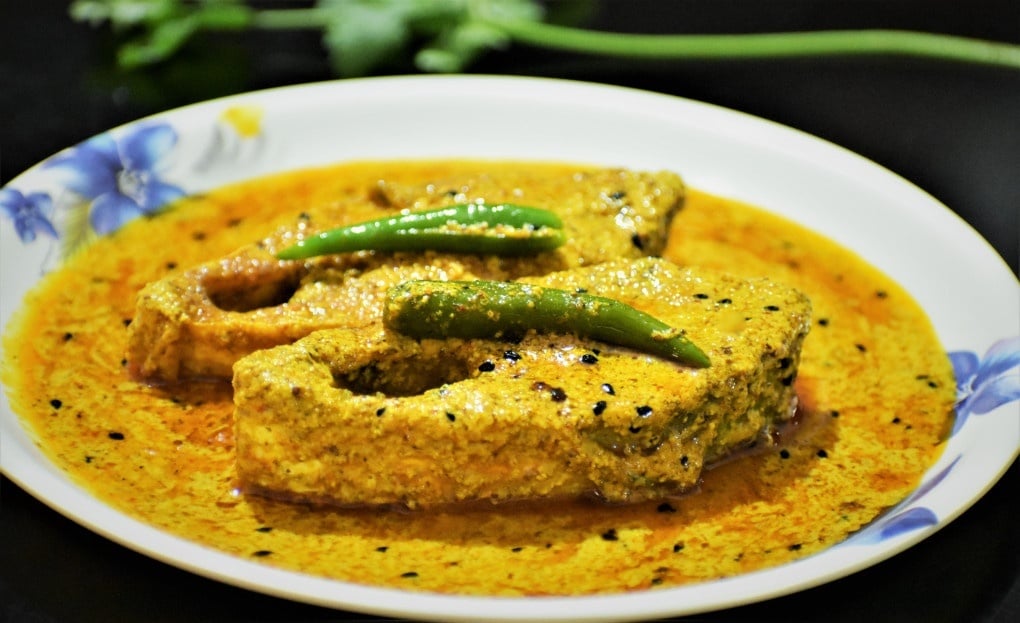
Prep Time
2 Minutes
Cook Time
15 Minutes
Yield
500 gm
Difficulty Level
Easy
On the off chance that you make a new mustard paste at home, soak 1 tsp dark mustard and white mustard seeds in the water and mix with one green chili and salt. Try not to utilize tiny mustard seeds. This way, the paste will be quite lovely, not better.
Ingredients
- Five pieces of hilsa fish
- 2 tbsp Mustard powder.
- 1/2 tsp Onion seeds or kalo jira or kalonji.
- 2 tsp red chili powder
- 1 tsp turmeric powder
- Salt to taste
- Mustard oil is about 3 tbsp for frying the fish and the gravy.
- 1/2 cup milk
- 3 green chilies, slited
Directions
- First, I’ll season the fish with 1/2 teaspoon salt and turmeric powder. Rub firmly.
- Then, in a pan, heat the oil.
- One by one, drop the fish pieces into the boiling oil. Over medium heat, cook for 1 minute on each side. Don’t fry the fish steaks for an extended period. We want to get rid of the natural odor. So a little frying might assist it in doing so.
- Set the pan aside after removing it from the heat.
- Put onion seeds (kalo jira) and green chilies in the same pan. Make sure the pan is sufficiently heated.
- Allow for the inherent aroma of the spices to emerge.
- Keep the flame low now. I’m going to add the turmeric and red chili powder to the pan right away. Mix everything quickly. Make sure they don’t burn.
- Toss in the mustard paste, salt, and a splash of water. Mix once more.
- Place the milk in the container. Instead of milk, you can use merely water. I used milk to increase the dish’s richness and creaminess.
- Ring the sauce/gravy to a rolling boil now.
- Place the fried fish pieces in the sauce once it is ready. Don’t over-stir the fish. It has the potential to break it.
- Now cover the pot for a minute.
- The gravy has reached the correct consistency after some time. It’s not as thin or as thick as it should be.
- It’s almost finished. Serve with additional green chilies on top. To keep the taste of the green chilies in the gravy, keep it covered until ready to serve.
- Serve with hot steaming rice.
- Servings: 5
- Ready in: 17 Minutes
- Course: Main Course
- Recipe Type: Fish, Lunch
- Ingredients: Fish, Mustard
Lentil and Meat Curry (Dal Gosht)
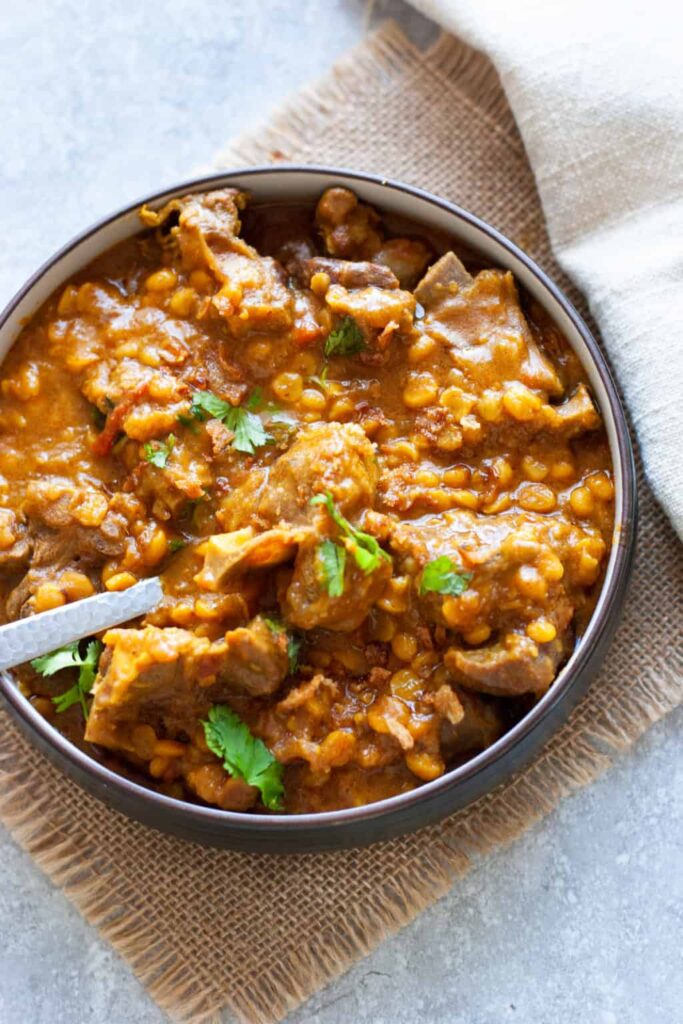
Dal gosht is a beef curry with a spicy lentil base that is both filling and tasty. The meat is cooked until soft before mixed with lentils, producing in a soupy or somewhat thicker consistency, depending on personal choice. This protein-rich meal originated in the kitchens of Hyderabadi royals and is now widespread in Muslim homes throughout India and Pakistan, with many variations.
Dal gosht is a dish that can make with goat, lamb, or even chicken. You can also make it with various lentils or a mix of several types of lentils. However, Split Bengal Gram is usually favored.
Prep Time 30 minutes
Cook Time 45 minutes
Servings 4 people
Ingredients
500 gms lamb curry (cut into pieces)
1 cup divided chana dal Bengal Gram is a kind of Bengal Gram.
2 finely sliced medium onions
3 finely diced medium tomatoes
2 to 3 chopped green chilies
1 tbsp garlic-ginger paste
3 tbsp oil + 2 tbsp tbsp tbsp tbsp tbs (for tempering)
1 sprig coarsely chopped coriander leaves
salt to taste
Spices used
1.5 teaspoon powdered coriander
1 tsp red pepper flakes, or to taste
1 teaspoon garam masala
a half teaspoon of turmeric powder
1 teaspoon cumin powder
To temper
1 small onion, finely sliced 2 tablespoons oil
a teaspoon of cumin seeds
2 to 3 dried red chilies
Directions
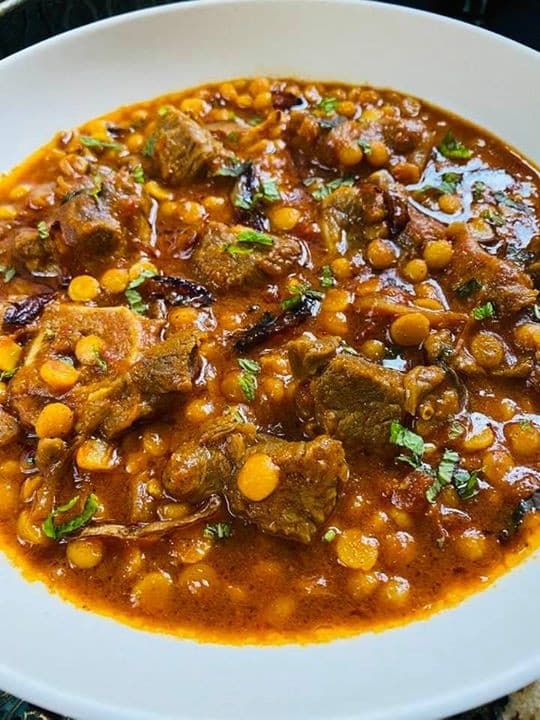
- Soak the lentils in water for 30 minutes after washing them. In a pressure cooker or a saucepan, drain the water and add the soaked lentils, salt, and turmeric powder.
- Boil the chana dal/lentils until they are soft and mushy. Should set 1 cup of the cooked lentils water aside.
- In a heavy saucepan, heat the oil. Fry the onions until they are tender and transparent over medium heat.
- Cook until the ginger-garlic paste is aromatic. Cook until the meat is uniformly browned on both sides.
- Except for garam masala, combine all of the spices.
- Cook the tomatoes until they are soft and nicely blended with the meat. Cook for 12 minutes or until the meat is soft.
- Combine the cooked meat with the boiling lentils and a bit more water. Cook for 10 minutes, or until the oil separates, covered. Should sprinkle garam masala on top. Depending on the consistency you like, you may add more or less water to make it soupy or thick.
- Serve with chopped coriander leaves as a garnish. Alternatively, if tempering, see the section below.
To temper
- In a small saucepan, heat 2 tbsp oil. Add cumin seeds and dried red chile and toast until fragrant.
- Toss the meat in the seasoned oil.
- Serve with your favorite side dish and garnished with chopped coriander.
Recipe Notes
This dish also works well as a one-pot dinner since the soaked lentils don’t need to be cooked separately and can be added after the meat is halfway cooked.
MUTTON LEG ROAST
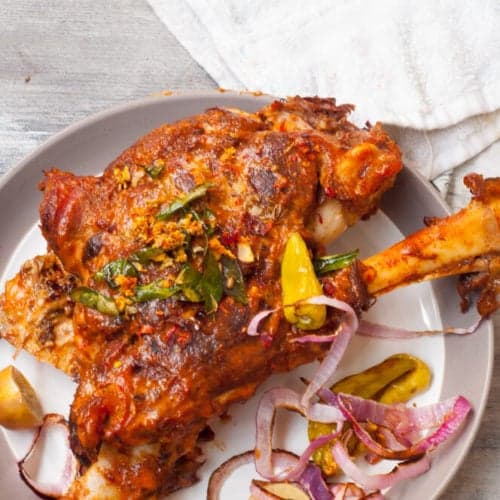
This is a straightforward and tasty roast leg of lamb dish, often known as leg roast or mutton leg roast. The secret to creating leg roast is the tender, melt-in-your-mouth meat. Continue reading to see the tips sections.
TIPS FOR MAKING SOFT LAMB OR MUTTON LEG ROAST:
CHOICE OF MEAT:
The mutton leg is the most crucial element in this dish. Meat from mature or extremely elderly goats is tough to tenderize. The same may be said for wild mountain goats. Obtaining meat from a younger goat (at least 2.4 years old, not a baby) might benefit. While this is the responsibility of butchers who know the proper meat for roasting, a video on the Good House Keeping website about acquiring mutton may be useful.
TENDERISE:
Marination is an excellent method for producing delicious, soft, and juicy meat without commercial tenderizers. Lemon juice and yogurt are used as natural meat tenderizers. Allow the mutton leg to marinate for 12-16 hours. And you have a tender, delicious lamb leg to eat.
Marinate:
- I prepared a spice combination for this mutton leg that can make ahead of time. This spice blend is intended for Bangladeshi Mutton Leg Roast.
- If you’re in a rush and don’t have time to prepare this spice blend. You may use raost masala or Indian curry masala.
- You may also add these to the spice mix if you want to experiment with the recipe and add your unique touch.
Optional ingredients
- 1 tablespoon desiccated coconut
- ½ tablespoon fennel seeds
- ½ teaspoon black pepper
Directions
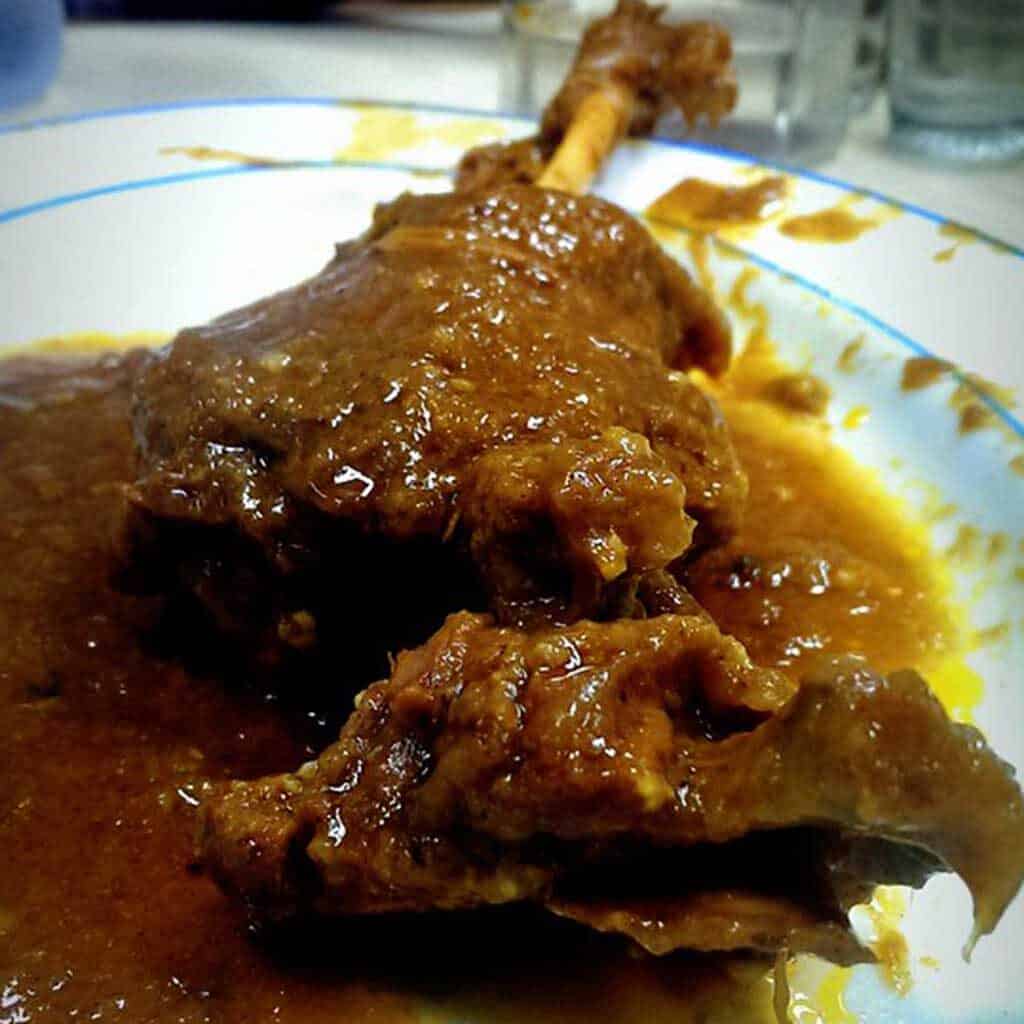
Depending on the type of meat, the cooking time varies considerably. When compared to fresh and older lamb, frozen and young lamb flesh cooks quickly. I use the slow cooking method and check at regular intervals. Cook until the meat is soft but not falling off the bone.
You may pressure cook the lamb leg if it fits in your pressure cooker. I recommend using a pressure cooker for 25 minutes or following the user manual directions. Cooking time should not be exceeded.
Prepare Spice Mix
Dry roast cumin seeds, coriander seeds, and red button chilies in a pan for 30 seconds. Add the powdered spices (red chili powder, whole spice powder, and salt) now. Transfer to a food processor after roasting for 2-3 seconds.
To make a fine powder, grind the spices. Using a fine strainer, strain the spice mixture.
Re-grind the leftovers in a sieve a second time. Re-sift the spice mixture and discard the remainder.
How to marinate:
Combine the yogurt, ginger, garlic, and lemon juice in a mixing bowl. Set aside after thoroughly mixing.
Wash the lamb/mutton leg well and trim away any extra fat. With a fork, pierce the leg all the way around. Pierce should have a deep voice. Rub the spice combination mixture all over the mutton leg and marinate it in the fridge for 8-12 hours.
The next day, place two cups of water and the mutton leg in a big saucepan and simmer for 2-3 hours on medium heat. Check every 30 minutes or as necessary. As required, adjust the heat and water. While cooking, flip the mutton leg once or twice. Mutton should become very delicate.
The mutton is done, and most of the water has evaporated. (If you prefer a little gravy and cook it in a saucepan, do not drain all of the water.)
Cooking Process:
Place the tomato ketchup, cream, and lamb gravy in a mixing bowl. Combine thoroughly. (If you enjoy spicy cuisine, use chili garlic sauce with the ketchup.)
Move the mutton leg to a baking pan and top with ketchup or cream sauce just before serving. Preheat the oven to 300°F as well.
If cooked in a saucepan, pour in the ketchup cream gravy and stir thoroughly.
In a small saucepan, heat the oil and combine all of the tempering ingredients. On medium heat, cook for 1 minute. Then drizzle the tempering over the mutton leg.
So here’s the leg roast, slathered in sauce and tempered with spices. (Note: Place half a cup of water in the tray to keep the mutton leg moist and to prevent it from burning from the bottom.)
If using a cooking pot, cover it immediately after applying the tempering. Simmer leg on low heat for 5-7 minutes, or until thoroughly heated. After that, serve. (If you want wet and juicy leg, add a cup of water.)
Bake the mutton leg at 300°F for 5-7 minutes, or until it, is roasted. (Place a half-cup of water in the tray.)
So that’s how delicious the lamb’s leg or leg roast comes out.
BHORTA – BANGLADESH’S ULTIMATE COMFORT FOOD
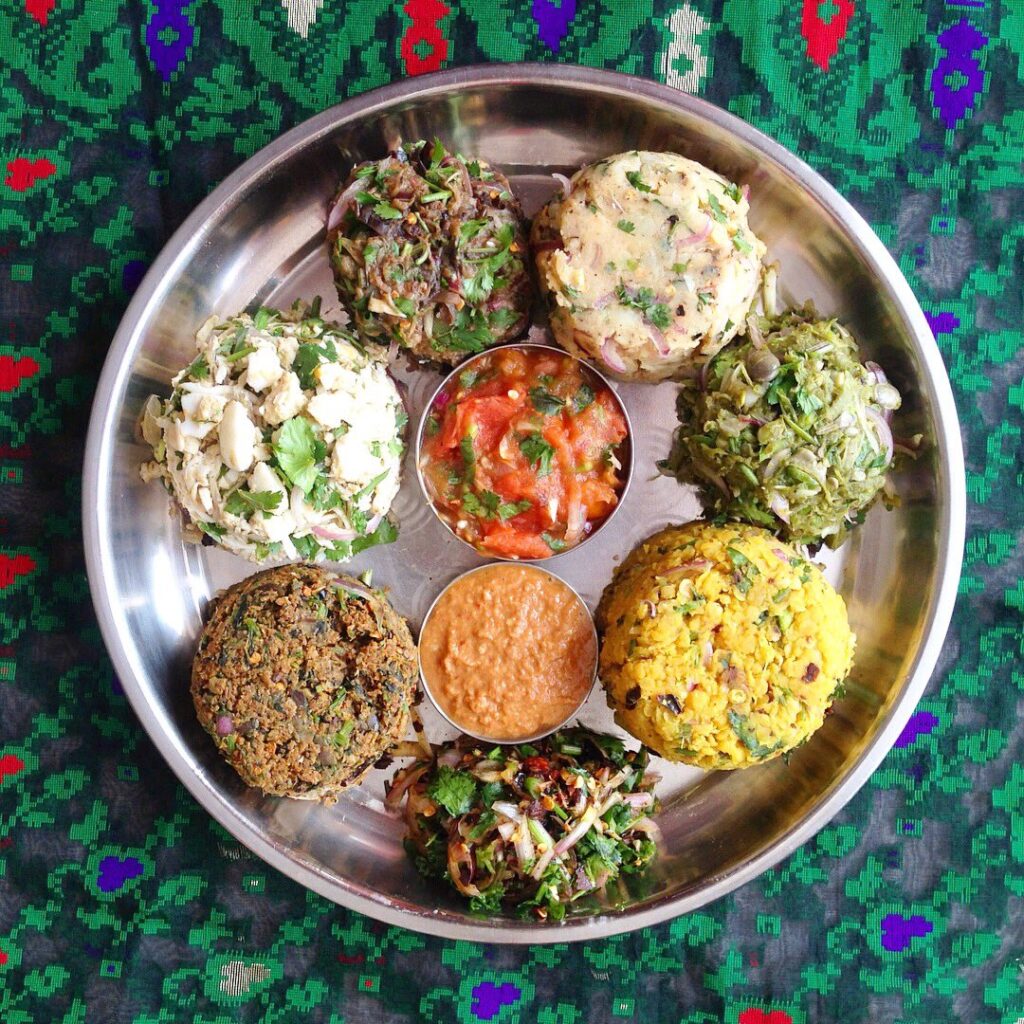
Bhortas are Bangladesh’s most important and ultimate comfort meal, eaten with rice. Bhortas are mashed delicacies prepared with mustard oil, onions, garlic, and red chilies that are tasty, smooth, spicy, and savory. You can mash most fresh or dried vegetables or fish with oil, onions, garlic, chiles, and occasionally cilantro or lemon juice to make a bhorta. Each mouthful of bhorta should include the crunch of sliced onion or the joy of golden caramelized onion, the sharpness of chile, and the scent of roasted garlic, depending on the kind.
Although each component may be cooked in a different way (boiled, roasted, or steamed), the main ingredients in Bangladeshi-style bhortas are mustard oil, garlic, and chile. The most common bhorta is the alu or potato bhorta. Alu bhorta is made by boiling potatoes and smooth mashing them. Lumpy potatoes are unusual, and there is no alternative for the very fragrant mustard oil used in Bangladeshi-style alu bhorta. After a few days of not eating rice or after a few days of eating a large meal, approximately 99 percent of Bangladeshis crave alu bhorta and bhat (rice) with some rice. Bangladeshis’ most uncomplicated yet most comfortable dish for people of all ages.
Roasted eggplants are used to provide a smoky taste in the first bhorta. Begun bhorta is not always as smooth as alu bhorta. I’ve roasted eggplant in the oven or on the stovetop by first covering it in aluminum foil. Both methods provide nearly identical results. If I can’t be in the kitchen, I use the oven because the cooktop technique demands frequent turns. A slight burn on the eggplant adds a beautiful taste to the beginning bhorta. Tomato bhorta is created in the same manner as eggplant bhorta.
Shutki, or dried fish such as shrimp, anchovies, and so on, is another star of the bhorta family. Shuki is an acquired taste, and not everyone in Bangladesh tries it, but trust me when I say that anyone who isn’t vegetarian and hasn’t had it has no clue what they’re missing. Once someone develops the taste, there is no going back. In terms of chile, it is the ultimate fiery bhorta. The more red chili you add, the better it becomes.
Another one that is high in protein and tasty is lentil or masoor dal bhorta. These are only a few examples of the many different types of bhortas. String beans, taro, tomato, pumpkin, broccoli, zucchini, fish fillets, sardine, and so on are also popular. Mom used to turn whatever vegetable my brother and I didn’t like into a lovely bhorta, sometimes with a hint of lemon juice, sometimes not, and there were no complaints around noon.
Mustard oil is sold in Bangladeshi and Indian supermarkets. If you must use another oil, sesame oil is a good choice. However, the flavor will be significantly different.
For Bangladeshis, bhortas are the most simple everyday dish. Unless you live outside of Bangladesh, they are rarely offered at a celebration or to a guest. Then we throw bhorta-themed parties that everyone looks forward to, and we forgo a meal before getting there to make sure there’s enough room in the stomach to gaze at as much bhorta and rice as possible. Everyone secretly hopes there will be leftover bhorta, but there is never any.
ALOO BHORTA – SPICY POTATO MASH
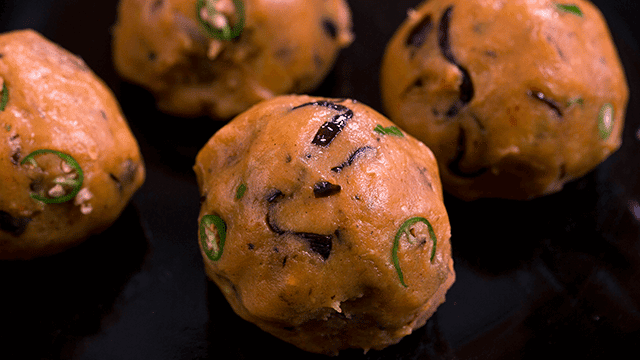
PREP TIME
10 mins
COOK TIME
15 mins
TOTAL TIME
25 mins
Step-by-step directions for creating Bangladesh’s most relaxing meal, Aloo bhorta.
Recipe type: Side dish
Cuisine: Bangladeshi
Serves: 4-5
INGREDIENTS
2 to 3 medium-sized potatoes
2 teaspoons mustard oil
4-5 garlic cloves
14 onion, finely sliced 2-3 red chilies
Season with salt to taste
Directions
- Roast the garlic and chili in the oven or on the stovetop.
- Boil the potato until it is tender.
- Peel and mash the cooked potato.
- Combine garlic, chili, and salt in a mash/paste. Add the onion.
- Mix in the mashed potatoes.
- Mix with the oil well.
NOTES:
This is a unique technique to prepare alu bhorta in Bangladesh. If you can’t stand raw potatoes, sauté onion in a skillet until translucent and golden. This results in a somewhat unusual yet excellent alu bhorta. Adjust the chili and garlic to taste. Instead of boiling, you may microwave the potato for 6-8 minutes.
EGGPLANT BHORTA – BEGUN BHORTA
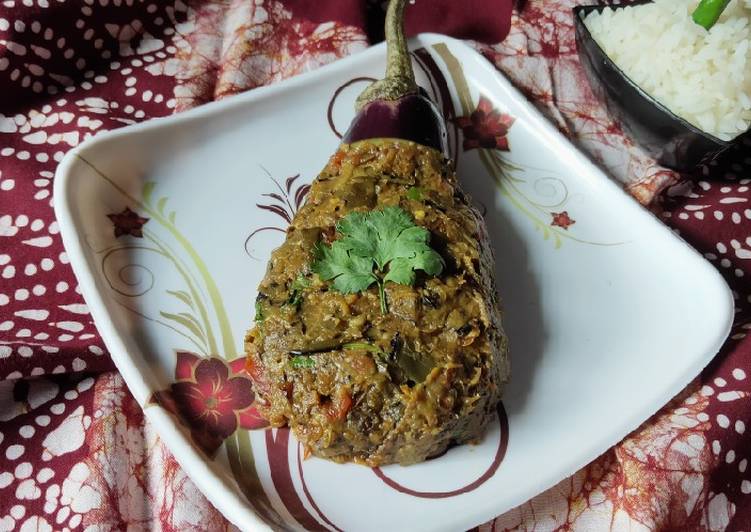
PREP TIME
10 mins
COOK TIME
20 mins
TOTAL TIME
30 mins
Spicy mashed eggplant, also known as started bhorta, is a traditional side dish served with rice in Bengali households. Find a step-by-step recipe and helpful hints for making your first batch of bhorta.
Recipe type: Side
Cuisine: Bangladeshi
Serves: 4-5
INGREDIENTS
1 large eggplant
2 teaspoons mustard oil
4-5 garlic cloves
14 onion, finely sliced 2-3 red chilies
Cilantro
Season with salt to taste
Directions
Roast the eggplant, garlic, and chili until soft, either on the stovetop or in the oven.
Combine garlic, chili, and salt in a mash/paste. Add the onion.
Mash together the roasted eggplant and the mashed potatoes. Garnish with cilantro.
Mix with the oil well.
NOTES:
I chop the eggplants into large slices and cover them in aluminum foil to roast on the stovetop.
Cut the eggplant into half-inch slices before roasting in the oven.
To taste, adjust the amount of oil, chili, and garlic.
SHUTKI BHORTA – DRIED FISH BHORTA
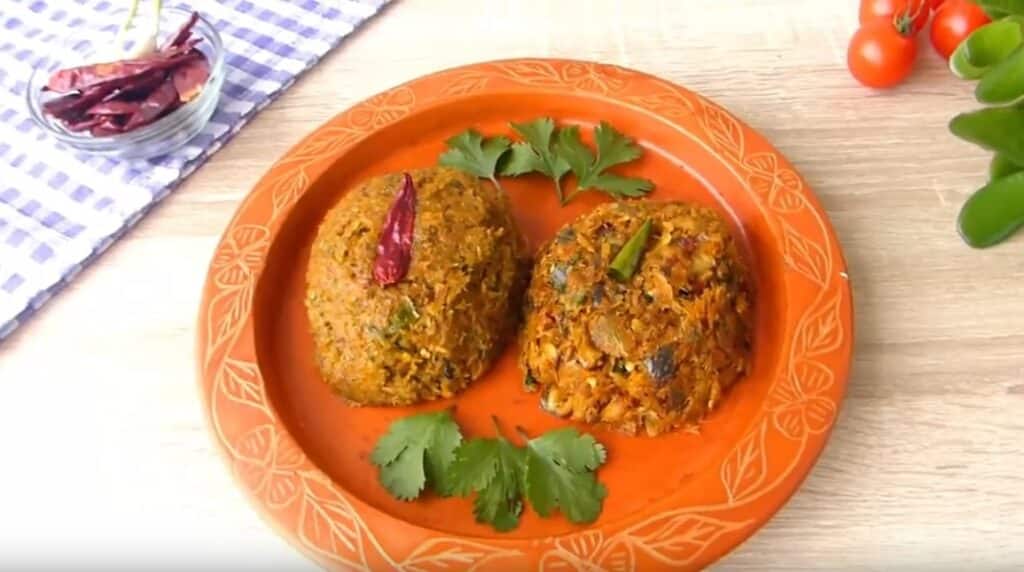
PREP TIME
5 mins
COOK TIME
20 mins
TOTAL TIME
25 mins
Shutki bhorta step-by-step recipe
Recipe type: Side
Cuisine: Bangladeshi
Serves: 2-4
INGREDIENTS
1 pound dried fish (shrimp, anchovy, etc.)
3 teaspoons mustard oil
4-5 garlic cloves
14 onion, finely sliced 2-3 red chilies
3 tbsp lemon juice
Season with salt to taste
Directions
Dry roast dried fish, garlic, and chili over medium heat.
Place everything in a food processor and pulse to combine.
NOTES:
Adjust the oil, lemon juice, chili, and garlic to taste.
Like What You Are Reading? Try Out Some Other Recipes.
3 diabetic-friendly desserts you can try
Easy Homemade Cheesy Beef Quesadilla Recipe
Easy Homemade Beef Tacos Recipe

